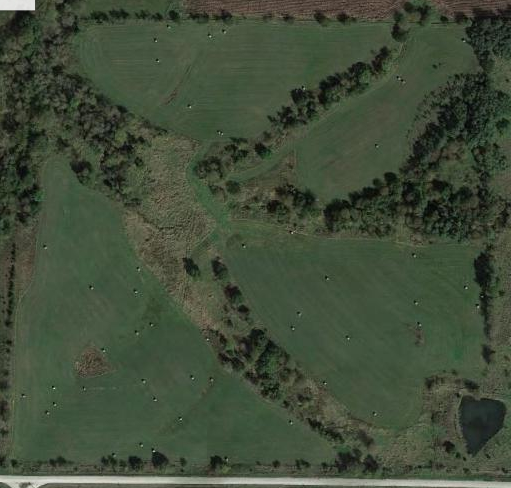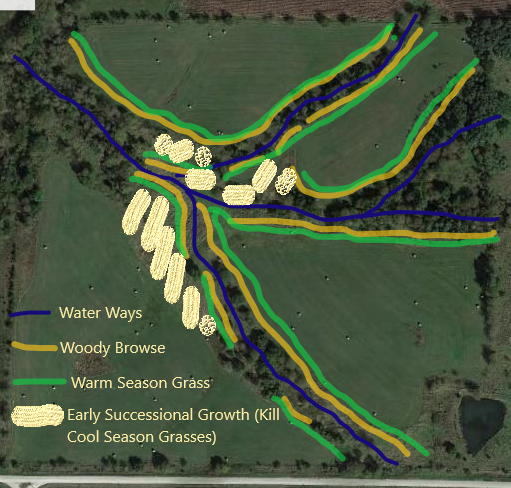Hunt 365, March 2018 Habitat Improvements Along Streams and Bottom Ground
Charlie Young who hunts in SW Iowa wrote in with this question about improving habitat around streams and bottom ground.
I read your article on hinge cutting and really enjoyed it. Seems like a cost-effective way to implement some cover into a property. The best part is you don’t have to have big machinery to do it!
It got me to thinking of what else I could potentially do to my property. I have a roughly 160 acres of family land in SW Iowa. I don’t own it outright but I can make wildlife improvement in certain areas on the property. It is cash rent cropland mainly with a stretch of stream bottom timber that dissects the property, with protruding fingers coming out.
I can make improvements to any part of the timber, the edging of the timber, and low-lying areas that don’t get planted on the property. Other than hinge cutting is there other fast producing cover options that I can do in these types of non-timber areas that will hold deer?
Any suggestions you can provide would be appreciated.
Thank you for the question Charlie! This question pertains to millions of acres of whitetail hunting grounds all across the country that have streams or other waterways on them…and even farms and other parcels that have ditches and draws that are farmed around. A very common land feature that many hunters and land owners don’t know what to do with to create better whitetail habitat.
The scenario plays out like this right…the most fertile and easily tillable ground is farmed up to and around ditches, draws, streams, and rivers. These areas hold some deer and wildlife, but because we are only dealing with small strips of cover, bedding habitat and nature food sources for wildlife (we are focusing on deer) is limited around the ditches and streams. Low-lying area are sometimes open for us to improve because it is hard for farmers to get their equipment in to farm that ground.
These areas can be great places to hunt whitetail. But all to often, after the fall harvest, these areas no longer support deer because the food sources are mostly gone (the beans, corn, etc.). Now the hunter has to rely on deer cruising through during the rut. Once that movement dries up, and food becomes a priority once again, hunting gets very tough.
Creating great habitat along these corridors can actually be achieved. So, lets break down the question into the three categories Charlie has identified: the timber, the edges, and the bottom ground.
Timbered Edges
Most edges around rivers, ditches, and other corridors have timber growing along them. The timber can in some cases shade the water in the streams and ditches keeping them cooler. If this is the case, and these streams contain fish or other wetland game, be careful not to disturb the timber in ways that can actually harm the stream/river. I only bring this up because I am no way qualified to give advice around this specific area. So…for purposes of this article, I am going to assume these areas are not trout streams, protected wetlands, navigable water ways, etc. If this is the case, the NRCS would definitely be the go to agency to help with ideas around improving these areas for better habitat.
Setting these scenarios aside, the timber along these areas can still be hinge cut in pockets. Many times, a farmer will not work the ground right up to the ditch in certain spots. These pockets where the timber can be wider and grow out from the ditch 20 or 30 yards can actually be big enough to hold deer. The best hinge cutting practice for these small spots are to only hinge a tree or two. Less is more in these scenarios as all you are really trying to do is establish some horizontal cover for the deer to bed up against or keep in front of them for security. Also, it does you little good to hinge cut a tree that falls in the ditch…hinge it out or alongside!
Edges
The edges of these corridors are where you can really get some good habitat. The question asks for fast producing cover…I’m not sure what the exact time frame is, but let me tell you what would be a good and permanent way to greatly improve this edge habitat.
I don’t know how much edge Charlie has to work with…10 yards…50 yards? But under ideal conditions, and still allowing the vast majority of the tillable ground to be farmed, some pretty good habitat can be obtained in a very small amount of edge cover. Let’s say you were given 20 yards on both sides of a ditch in which to improve the habitat. A half mile stretch would be just slightly over 7 acres of land. In many cases, there might be that much or more already available along most ditches and draws. If you have more…or less than this to work with, just adjust what I’m about to explain!
Deer love edges, especially edges that have food and cover. This can be obtained with very little acreage. Using the 20 yards example, what you want to do is create an edge that has layers of differing cover types. First, along the field or crop edge (starting at the field and working in to the ditch), plant or establish the first 10 yards in a warm season grass blend. I like a blend that contains stiff stemmed grasses like switchgrass. This provides a barrier for the deer to feel secure all along the ditch. It also provides bedding cover and thermal protection for deer.
Next, plant the remaining 10 yards in a variety of brushy cover up to the timber…intermixed with the timber…or where there is no timber. Native brushy plants could include red and grey dogwood, American hazelnut, ninebark, elderberry, and highbush cranberry to name a few. These plants can be obtained from an Iowa DNR nursery for a very reasonable price. The woody brush type plants provide food and additional cover. If you don’t have the money, another possible alternate for this “woody browse” type strip would be to simply use a grass specific herbicide multiple times per year…for a couple years and let nature take its course. When you eliminate competition from cool season grasses, you allow native broadleaf plants to germinate and grow. You might get blackberries, dogwoods, willows, and other broadleaf forbs to grow in this strip. The downside is you never know what you are going to get; however, in many cases by just eliminating the grass vegetation you get much more preferred vegetation and woody browse.
The effect is a tapered edge starting with tall native warm season grasses, working into lower growing woody browse, and finishing off at the very edge with full size trees. This tapered edge is great wildlife habitat and deer love it! The grasses will establish in two years, and the woody brush will be at 4-5 feet in a year or two as well. Add a few hinge cut trees that fall into the woody browse and warm season grasses and you have yourself an excellent corridor that will hold and feed deer most months of the year.
If you can’t go 20 yards wide on both sides, do one side. Can’t do 20 yards…do 10 yards. If you don’t have the time or money to do a project like this in one year, make it a 4-year project. The farm will see benefits in less wind and water erosion. In many cases, the land owner can actually get financial assistance from the NRCS (Natural Resources Conservation Service at the county USDA center) for putting these strips in. In the world of the NRCS, this type of habitat could be called a riparian buffer. These tapered edges are some of the best habitat structures you can possibly create on these types of farms!
The Bottom Ground
In the question, Charlie also wants to know a good way to create better habitat in low-lying areas or what I refer to as bottom ground. Bottom ground that is not tilled is usually not farmed because it is wet. I’m assuming this is the case here. Bottom ground is also usually very fertile soil. This is a great place to adopt the strategy of creating tapered edges as earlier described. Or, again, by simply spraying all the bottom ground with a grass herbicide you allow the local seed bank to kick into high gear when it is no longer held back by the dense and fast growing cold season grasses that naturally occur here. If the bottom ground is large in acreage, you can create tapered edge cover including the warm season grasses along the ditch edge, and then spray the remaining acreage with a grass herbicide and let nature take its course. You might have to spray with a grass specific herbicide for several years to give the broadleaf woody vegetation a chance to establish…then nature will take care of itself. Native plants over time will fill in the bottom field with great food and cover and all you did was kill the grass…not a bad tactic that takes very little effort or time. If native woody browse doesn’t fill in what you’ve sprayed, you can always go back and do your own planting.

Hunting farms like this one are great for whitetails but can be hard at times to hold deer because of a potential lack of bedding and security cover.

This would be a great example of a habitat plan for a ditched and/or bottom ground farm. By taking up just a little of the edging and sacrificing some tillable ground you can actually create great year round habitat for deer.
So, as you can see there is actually quite a bit more you can do to provide great habitat without breaking the bank. Please continue to send in questions to tapeppy@gmail.com.
Note: In this article, I referred over and over to killing cool season grasses…and establishing warm season grasses. These varieties are very different from each other. An example of a cool season grass is the low growing and very useless to deer broam grass. An example of a warm season grass is the tall and woody switchgrass that can grow to 7 feet tall and stays standing in winter and high winds. The two are not equal. The warm season grasses have to be establishes by you by planting them. Cool season grasses occur readily in nature and will take over a landscape if left unchecked. Warm season grasses are far superior in terms of whitetail habitat. And, whenever establishing habitat make sure to promote native species and beware of and control invasive species.
